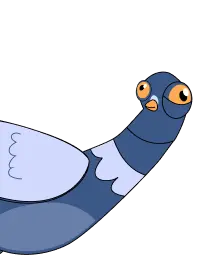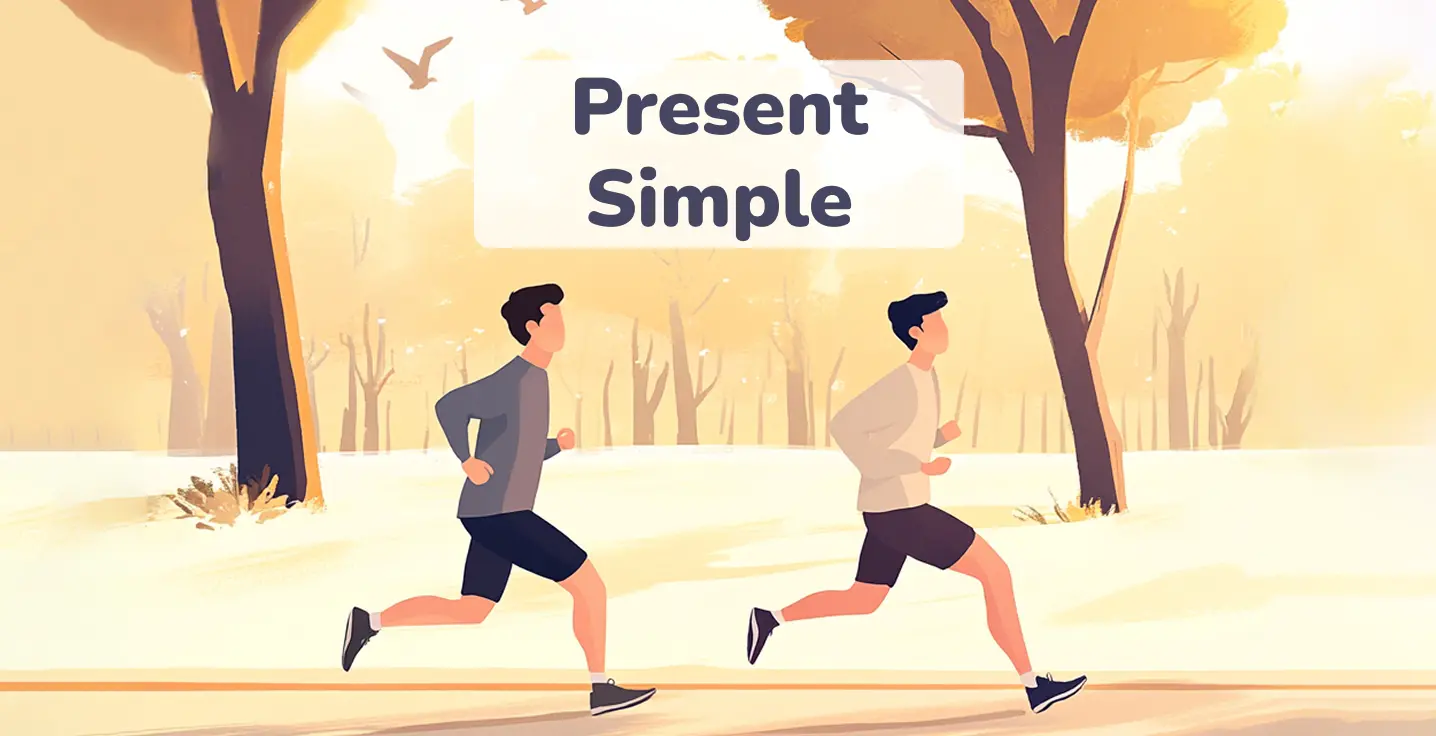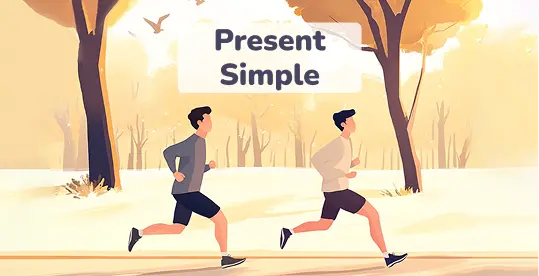What is the Present Simple?
The Present Simple is the verb tense used to speak about actions that repeat, sometimes, never, always. It is also for habitual things we do, like when we drink tea every morning or read a book before sleep.
The tense is also called Simple Present or Present Indefinite. It is easy to build sentences in this tense, but there are a few nuances you need to know to understand it fully.
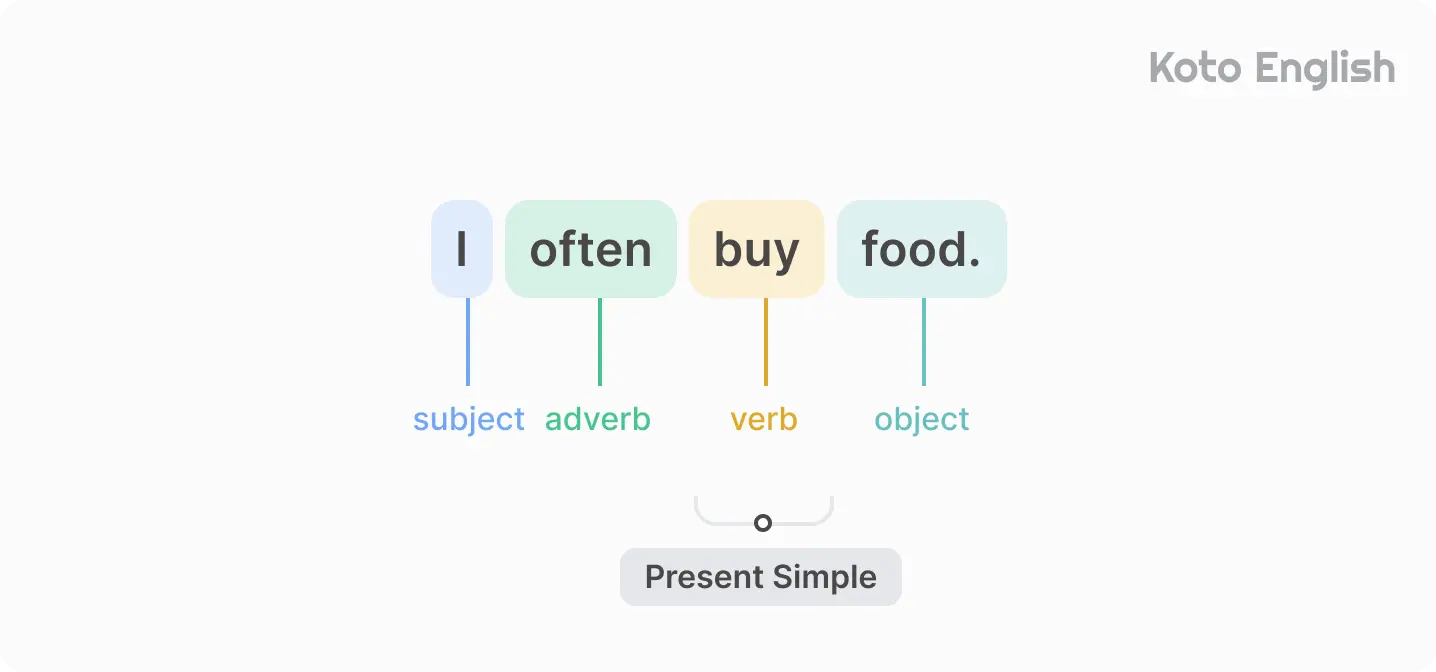
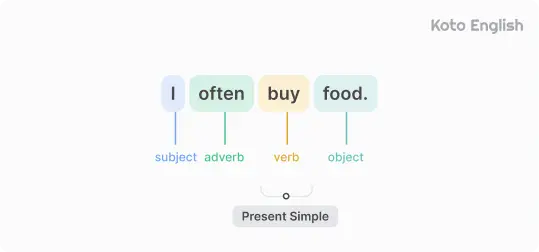
Present Simple examples:
Level up your English with Koto!
Present Simple structure
The structure of Present Simple is easy and only touches the verb. To form a sentence, you need to take the base form of the verb (to run, to meet, to walk, to cook).
+ the verb in its -ing form (present participle). This Present Continuous structure helps express actions happening now or planned for the near future.
Then you add -s , or -es ending to the verb if it is a third-person singular (he, she, it). The other subjects (I, you, we, they) go with a bare infinitive — the root form without the particle to.

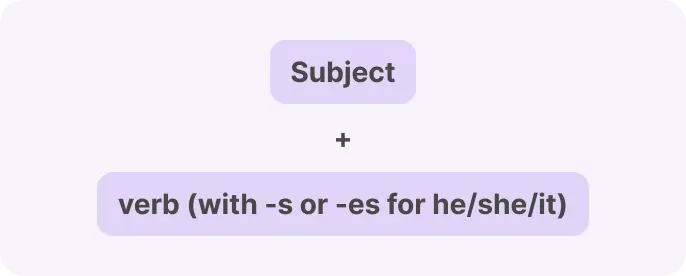
Look at how the verb changes based on the person:
| Subject | Full form |
|---|---|
| I |
I
|
| You |
You
|
| He |
He
|
| She |
She
|
| It |
It
|
| We |
We
|
| They |
They
|
| You (plural) |
We
|
To memorize the grammar quickly, practice with your daily routine. Write what you do every day by the hour.
When do we use the Present Simple?
There are many cases of using Present Simple. You can even write a short article using only this tense — it illustrates its usefulness.
Take a look at the cases and Present Simple tense examples below:
| Usage | Examples |
|---|---|
| Repetitive, habitual actions |
I
|
| States and conditions |
I
|
| General truths or facts |
The USA
|
| Scheduled events in the future |
The plane
|
| Instructions |
|
| Pointing direction |
|
| Phrases with adverbs of frequency |
I always
|
Tense markers for Present Simple:
| Time indicators | Examples |
|---|---|
| Always, usually, sometimes, rarely, never. |
I rarely
|
| Every day/week/month. |
He
|
| Once a year, twice a week, three times a month. |
We
|
| In the morning, in the afternoon, in the evening, |
They
|
| At 7 a.m., at 5 p.m. |
You
|
Long phrases like once a week, every month, or in the morning typically go to the end of the sentence in the Present Simple sentences. Adverbs of frequency (always, usually, sometimes) are placed after the subject (I, You, They) and before the verb (go, visit, spend).
How to use the Present Simple tense?
We discussed the Present Simple definition and the cases of its usage. Now, let’s explore other nuances.
Present Simple: -s and -es form spelling
We said before that the ending can be
| Base form + -s ending | Example |
|---|---|
| walk → walk |
Your sister |
| eat → eat |
His cousin |
| wait → wait |
Jeremy |
| work → work |
Samantha |
After the verbs that end in these letters:
| Base form + -es ending | Example |
|---|---|
| catch → catch |
My friend |
| pass → pass |
My cousin always |
| wash → wash |
This machine |
| fix → fix |
That master |
| go → go |
Her brother |
The spelling for words ending in
| Base form + -ies ending | Example |
|---|---|
| study → stud |
AI |
| cry → cr |
My daughter sometimes |
| try → tr |
She |
| reply → repl |
He always |
If a word has a vowel at the end, followed by
| Base form + -s ending (after y) | Example |
|---|---|
| stay → stay |
She |
| play → play |
It |
| enjoy → enjoy |
He |
| say → say |
She always |
There are also some irregular cases. For instance, the verb to have changes into has.
Enjoy personalized learning!
Present Simple Negative
Creating a negative sentence in the Simple Present tense requires us to add a special auxiliary verb, do , for I, you, we, they, and does for he, she, it.


Examples:
In negative sentences, we can use both long forms and constructions. The short form is constructed by joining the words do not and does not:
| Subject | Full form | Short form |
|---|---|---|
| I |
I
|
I
|
| You |
You
|
You
|
| He/she/it |
She
|
She
|
| We |
We
|
We
|
| They |
They
|
They
|
| You (plural) |
You
|
You
|
Present Simple questions
To create a question in the Present Simple form, we take the aforesaid verbs (do and does) and put them at the beginning. The subject follows after the auxiliary word, and the main verb comes after the noun.
Yes/no questions in Present Simple


| Question | Answer |
|---|---|
|
|
I |
|
|
|
|
|
They |
Sentences with WH-question words:


| Question | Answer |
|---|---|
|
|
I |
|
|
He |
|
|
They |
We change the form of the verb when the sentence is positive, but when it is negative, or question, do and does indicate the tense, so we don’t add any endings.That’s why: Does he work here? but not Does he works here?
That’s why: Does he work here? but not Does he works here?
The verb to be
We don’t use the auxiliary words when there are no verbs in the sentence. That’s why when we want to say that we are not happy or ask if another person is tired, we need to know the rules of using the verb to be in Present Simple.
It has three forms, which we use based on our subject.
Only by using this grammar structure can you tell a lot about yourself.
Present Simple uses with to be:
| Positive | Negative | Questions |
|---|---|---|
|
I
|
I
|
|
|
He
|
He
|
|
|
She
|
She
|
|
|
It
|
It
|
|
|
You
|
You
|
|
|
We
|
We
|
|
|
They
|
They
|
|
Common mistakes with Present Simple tense in English
The Present Simple rules are not complicated. But it is easy to make many mistakes when you use it. We collected the most repetitive errors for you to know what to focus on:
Choosing to be form instead of do and does
Remember, the main difference between these two cases is that we choose do and does when there is a verb in a sentence, an action, or a state (to run, to feel, to know, to study the Present Simple), and we use am, is, are when a subject is followed by adjectives (happy, smart, nervous, hungry, thirsty):
|
I am not agree with you.
|
I don’t agree with you.
|
|
He is play the guitar.
|
He plays the guitar.
|
Forgetting about auxiliary verbs
Another wrong way of speaking and writing is forgetting about a tense word. It is very important not to ignore it because it is only one indicator of time we have in a sentence, especially in simple tenses:
|
They not know.
|
We don’t live here.
|
|
Do she want to buy food?
|
Does she want to buy food?
|
Misusing auxiliary verbs by a person
Present Simple grammar entirely depends on the person. We always use do or don’t if it is first person singular or second plural. When it is third person singular, we need to spell does or doesn’t.
|
We doesn’t live here.
|
We don’t live here.
|
|
Do she want to buy food?
|
Does she want to buy food?
|
Subjects are more than just he, she, it, or you, we, they. My brother, the sofa, our apartments, my doctor’s wife are also subjects, and it would be good to practice it separately.
Summary
So what is the Present Continuous? To wrap it up, this tense is essential for expressing ongoing actions and scheduled events, helping you speak more fluidly in the present moment. With practice, avoiding common mistakes will make it even easier to use.
Present Simple tense FAQ
This tense is widely used in daily life to describe regular actions. Use the Present Simple when you talk about:
- likes and dislikes;
- habits;
- schedules;
- instructions;
- permanent states.
For example:
When you form a third-person singular structure of the Present Simple, you need to add ending -s or -es to the base form of a verb. In most situations, you choose -s, but if a verb ends in –ch, –ss, –sh, –x, –o, add -es.
You use the Present Simple to discuss what you do from time to time, once a day, three times a week, or to describe general truths.
If you want to discuss something happening right now, at the moment, you need to use Present Continuous:
Making mistakes is part of the learning process. There are a few errors you need to remember to avoid when you study the Present Simple tense:
- Forgetting about the -s/-es ending:
|
He always answer every question.
|
He always answers every question.
|
- Using am, is, are with verbs:
|
I am like taking photos.
|
I like taking photos.
|
- Misuse the auxiliary verb do/does:
|
He don’t water the plants.
|
He doesn’t water the plants.
|
